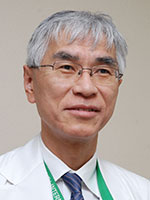Speakers

Prof. Shigeru MAKITA
Professor, Department of Cardiac Rehabilitation, Saitama Medical University International Medical Center, Japan
- Current activities
President of Japanese Association of Cardiac Rehabilitation
Director of Japanese Society of Clinical Sports Medicine
Delegate of Japanese Society of Rehabilitation Medicine
Member of German Society for Sports Medicine and Prevention - Degree of Qualification
1983 MD Niigata University, Faculty of Medicine
2010 Professor of Saitama Medical University - Research
1987-1989, 1995-1996 German Sports University, Institute for cardiology and sports medicine (Univ.-Prof.Dr.med.Dr.h.c.W.Hollman and Prof.Dr.med.R.Rost) - Research Area
Cardiac rehabilitation, Cancer rehabilitation, Exercise physiology, Sports medicine
Abstract
Cardiac Rehabilitation in Heart Failure
In Japan the number of our population is about 120 million and the total number of heart failure (HF) patients counts about 1,200,000. Especially elderly HF patients are increasing. Our population has been decreasing by about 250,000 annually in the past several years. The ratio of elderly people aged 65 or older to Japan’s total population has reached 28.4% which is the highest one in the world. From JCARE-CARD study (Circ J 2006) revealed that more HF patients had comorbidities such as hypertension, diabetes mellitus, chronic kidney disease, anemia and atrial fibrillation and that 1-year mortality was7.3% and readmission rate within 1-year was 35%. The most commonly identified cause for hospital readmission was lack of compliance with medical and dietary treatment.
It has also been pointed out that sarcopenia and frailty predict the long-term prognosis of elderly patients with HF. As a result of meta-analysis on HF, Denfeld (Int J Cardiol 2017) reported the prevalence rate of frailty was 43% at a high rate.
Accordingly, out-patient and home-based interventions are essential for elderly patients with HF and noncardiac comorbidities with a high risk of rehospitalization to improve QOL and exercise capacity and prevent rehospitalization and conditions requiring nursing care. Many studies have reported the efficacy of multidisciplinary intervention/disease management programs in patients with HF, and a systemic review has concluded that multidisciplinary interventions significantly reduce rehospitalization rates and all-cause mortality in patients with HF.
Japanese Circulation Society published Guideline on Diagnosis and Treatment of Acute and Chronic Heart Failure in 2019. In the session of exercise therapy of this guideline, the item “For patients with HFrEF, conduct exercise therapy as ambulatory cardiac rehabilitation (CR) sessions to improve symptoms and exercise capacity” is Ⅰ in class of recommendation and A in level of evidence
Kamiya (Circ Heart Fail 2020) reported that outpatient CR participation was associated with substantial prognostic benefit in a large HF cohort regardless of age, sex, comorbidities, frailty, and HF with preserved ejection fraction. But according to the first nationwide survey (Circ J 2019) demonstrated that the implementation rates of multidisciplinary care and CR for HF, especially for outpatients, are low in Japan. The spread and continuation of CR is an important issue in Japan.
Cardiac Rehabilitation in Japan during COVID-19 Epidemic
Coronavirus Disease 2019 (COVID-19) has become the global threat which rapidly increases the number of infected patients in Japan, particularly in the main urban areas. There are still no signs of termination yet.
On 7th April 2020, the Japanese government first declared a national state of emergency over the novel coronavirus outbreak for the seven prefectures including main urban areas and announced that the risk of the occurrence of clusters was particularly high when the 3Cs overlap each other. It is quite difficult to avoid close-contact settings, including "Closed spaces with poor ventilation", "Crowded places with many people nearby" and "Close-contact setting such as close-range conversations", in cardiac rehabilitation (CR). Therefore, it is indispensable to enforce sufficient measures to prevent the infection among health care providers and patients receiving CR and the spread of nosocomial infection and to continuously provide appropriate and safe CR and cardiopulmonary exercise testing (CPX).
We have no data from detailed researches concerning the status of CR in Japan under the COVID-19 outbreak; thus, it is urgently required to investigate the current CR situation. A questionnaire survey was conducted in the CR training facilities to figure out what measures were taken against COVID-19 outbreak after the government’s declaration of a state of emergency.
We conducted an online questionnaire survey to the 40 Japanese CR training facilities on April 13, 2020. The obtained data were compiled by the Public Relations Committee of the Japanese Association of Cardiac Rehabilitation. The questionnaire survey included basic information of facilities, exercise therapy implementation, exercise testing, cardiac telerehabilitation, patient guidance, and other aspects affecting CR implementation and education. From the results of questionnaire, we assessed the differences in facilities and regions.
In parallel with the questionnaire survey, the Japanese Society of Cardiology organized a special team to tackle COVID-19-related matters, to disseminate promptly information and to suggest collaborations with the other departments and hospitals.
